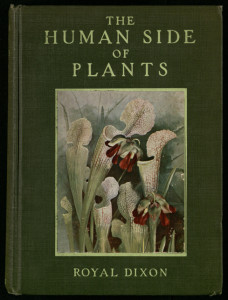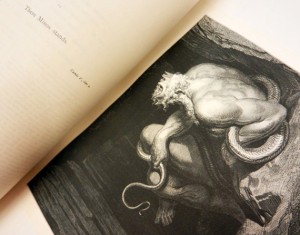
Karla A. Lira is a Ph.D. History student at the University of Houston. Lira’s research focuses on multi-racial dynamics of Latinos and Blacks in the space of Basketball during the 1960s. Her current project, “True We’ll Ever Be,” sheds light on the social relations Latinos and Blacks had in the city of Houston and the University of Houston Basketball Program through oral interviews. She was kind enough to share some of her research with us below.
“And to thy memory cherished, True we’ll ever be.”
HOUSTON, March 2019 — After the Spirit of Houston band finished the last stanza, first comes Galen Robinson Jr., then Armoni Brooks, followed by Corey Davis Jr., and the rest of the Men’s Basketball team to “The Cage,” the specially designated courtside student seating section, to high five all the student fans in a new cougar tradition. Black, Latino, Asian, all races celebrate together at the Fertitta Center as the University of Houston, one of the most diverse universities in the nation, celebrates another victory.
This freedom of celebration, race inclusion, and community was not always the case.
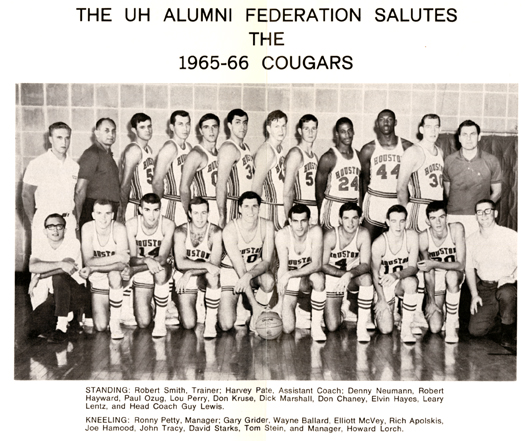
from the UH Alumni Federation Basketball Appreciation Dinner program (1966), Athletics Department Records
In 1962, the university integrated and signed the first African-Americans, Elvin Hayes and Don Chaney to play basketball. The social transition was eased by various people including Coach Guy V. Lewis, Harvey Pate, and student manager Howard Lorch. These individuals challenged the societal prejudice against the Black community. As Elvin “BIG E” Hayes recalled, student athletes such as Don Chaney, Warren McVea, and others helped create this integrated environment which everyone can enjoy.
Because of Houston’s unique history of desegregation and racial dynamics, I am researching Latinos in the basketball sphere. I am building my research on Katherine Lopez’s Cougars of Any Color: The Integration of University of Houston Athletics, 1964-1968, which emphasizes the many facets of racial integration at the university’s athletics program in the 1960s. I am also using The University of Houston Athletics Department Records in Special Collections where I have found pamphlets, donor records, and program guides that have uncovered race relations during the Civil Rights Era at University of Houston. My research breaks the Black and white racial dynamics by adding Latinos into the conversation.
The hardships of Hayes, Chaney, and McVea’s experience have set the pathway for diverse athletes to be here. This 2019 season is special. The UH Men’s Basketball Team won the regular season American Athletic conference championship, were the first to make it to the NCAA Sweet 16 since the Phi Slama Jama reign, were the first in the history of the institution to host ESPN’s College Game Day, and were one of the seven teams chosen by the NCAA to be part of their March Madness Confidential Series. The Cougars broke several records; Corey Davis Jr. has scored more than 1,000 points, making him the 48th player to accomplish this at the institution. The eccentric senior, Galen Robinson Jr. has triumphed in over 100 victories during his time in the Cougar uniform and is still counting.
With March Madness reaching its crescendo, it is important to give credit and acknowledge those that broke the racial barrier and made it possible for student athletes, coaches, staff, and students to come together and enjoy this communal winning moment. Go Coogs!
Special thanks to Elvin Hayes and Howard Lorch. Your kindness is felt.
The University of Houston Special Collections is proud to announce the publication of a new finding aid for the Herman George Eiden Papers. Sara Wheeler, graduate student intern from the Simmons School of Library and Information Science, has recently completed the processing of the papers, penned the new finding aid, was generous enough to share her thoughts on the new collection below, as well as present some highlights from the collection via a small exhibition currently on display at the entrance to Special Collections, near the Morrie & Rolaine Abramson Grand Staircase.
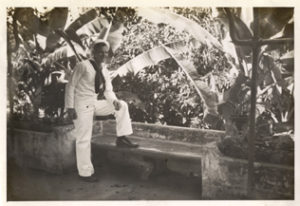
At the aquarium, Manila, Philippines, November 1940 (Herman George Eiden Papers)
In 1939, 18-year-old Herman George Eiden joined the United States Navy. Like many his age, Eiden had the opportunity to see the world through his service. Eiden was able to take photographs of his travels, send letters home, and even film some of his travels. He was able to do this all while aboard the USS Lexington and then USS Houston (CA-30). The University of Houston Special Collections recently received the donation of these photo albums, scrapbooks, films, and letters of Eiden’s for inclusion among the USS Houston & Military History collections.
The Herman George Eiden Papers include three photo albums, memorabilia, and clippings that Eiden put together and sent home to his family in Louisville, Kentucky. In the photos, Eiden captured his travels to Panama, Hawaiʻi, Guam, China, and the Philippines. Most of his time was spent in the Philippines, where he and his shipmates were able to take in the local color, enjoying sightseeing trips to places such as Old Manila, Pasig River, and Pagsanjan Falls.
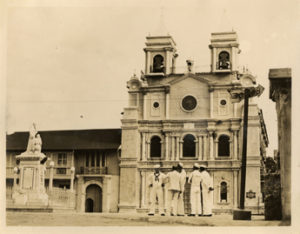
Church of the Third Order of the Franciscans (Herman George Eiden Papers)
The photos include life aboard the USS Houston (CA-30). There are images of Navy sailors swimming off the side of the ship, boxing matches, as well as pictures of the ship’s band. Also included are photos of the changing of command, as Captain Rooks takes over for Captain Oldendorf.
Eiden also sent six film reels home. These film reels have all been digitized to allow quick and easy access for contemporary scholars. Along with the reels, Eiden included a narrative log that provides details to correspond with each part of the film.
While serving in the Navy, Eiden achieved the rank of Fireman First Class. He was aboard the ship during the Battle of the Java Sea and the USS Houston’s final battle, the Battle of Sunda Strait. Eiden, alongside 692 of his comrades, perished during this attack on March 1, 1942.
After the sinking of the USS Houston, it took almost nine months for news of the fate of the ship and her crew to reach home. Eiden’s family saved his obituary and news articles about the sinking of the USS Houston (CA-30) that were published in their local newspaper, The Courier-Journal of Louisville.
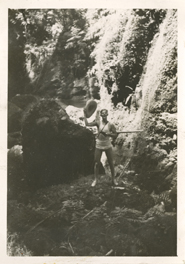
“Well, so long! Hope you have enjoyed my pictures.” Herman George Eiden, February 1941 (Herman George Eiden Papers)
One of his sisters, Clara Imelda Eiden Sivori, also received the USS Houston (CA-30) Survivors Association and Next Generations newsletters, which are a part of the collection. She and other relatives were able to attend the 60th commemorative ceremony in Houston for the USS Houston (CA-30) and those photos are also included in the collection.
Those interested in getting a closer look at the Herman George Eiden Papers are encouraged to see it in person by visiting our reading room, as well as visiting the two exhibit cases just outside of the entrance to Special Collections where select materials are on display for a limited time. Finally, those interested in more information on this collection or the Cruiser Houston Collection should contact Christian Kelleher, Head of Special Collections and curator of the USS Houston & Military History collections.
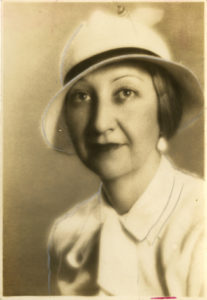
undated portrait of Joyce Burg, from the Betty Trapp Chapman Papers
The University of Houston Special Collections is proud to announce the publication of a new finding aid for the Betty Trapp Chapman Papers. Emily Brooks, Graduate Assistant for the Carey Shuart Women’s Archive, has recently completed the processing of the papers, penned the new finding aid, and was generous enough to share some of her thoughts on the new collection.
In 2004, Ellen Elkins Grimes, Chair of the Women in the Profession Committee of the State Bar of Texas was asked to give a speech about the history of female lawyers who paved the way for today’s women in law. She quickly realized that there was very little information available, especially regarding the early female pioneers of the law in Texas. She decided that the State Bar association should sponsor a book on the history of Texas female lawyers and appointed Betty Trapp Chapman, a prominent Houston historian to complete the research and writing of what would become Rough Road to Justice: The Journey of Women Lawyers in Texas (2008). Chapman is the author of several books on Houston and Texas history such as Historic Houston (2011) and Houston Women: Invisible Threads in the Tapestry (2000).
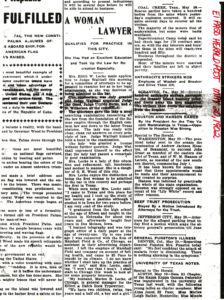
“A Woman Lawyer” (El Paso Herald Post, May 20, 1902, Betty Trapp Chapman Papers)
From Edith Locke, the first woman licensed to practice in El Paso in 1902, to nationally prominent Texas women like Sandra Day O’ Connor, Kay Bailey Hutchinson, and Sheila Jackson Lee, Rough Road to Justice tracks the journey of these women as they overcame discrimination and harassment to succeed in the legal profession. Chapman explores broad social issues that impacted women in the legal profession as well as individual trailblazers that made it possible for women to pursue careers in law today. One such woman was Joyce M. Burg, the first woman to practice law in Houston after she graduated from the University of Texas Law School in 1926 – one of only four women in her class. She went on to become the “grand dame of Houston’s family law system,” practiced law for 60 years and founded the Harris County Women Attorneys Association. When she passed away in 1997 at the age of 96, she was the oldest member of the Houston Bar Association.
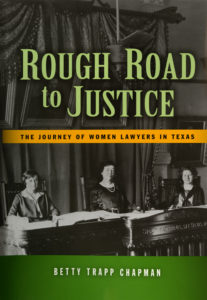
cover of Rough Road to Justice: The Journey of Women Lawyers in Texas (2008)
This collection enriches the Carey C. Shuart Women’s Archive and Research Collection with the often-untold stories of Texas women in the law, unique correspondence with these women and their descendants, as well as original photographs of several of the women featured in Rough Road to Justice. For more information, we invite you to visit our reading room where the Betty Trapp Chapman Papers can be explored.
The following comes to us courtesy of Elizabeth Barnes, who just wrapped up an internship through the Graduate Program in Public History, for which she processed numerous archival collections including the Royal Dixon Papers.
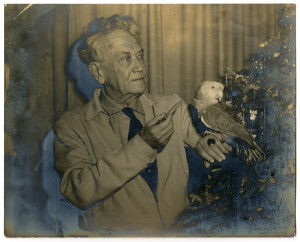
Royal Dixon and bird (December 1956, Royal Dixon Papers)
Special Collections at the University of Houston Libraries announces the opening of the Royal Dixon Papers to the public.
Royal Dixon was a native of Huntsville where he later attended Sam Houston State University. His academic pursuits continued when he held the status of a special student at the University of Chicago and Columbia University. Dixon’s long literary career began with a post at the Houston Chronicle and continued with many short stories and novels. Nearly all of his writing focused on nature and was characterized by the common theme of anthropomorphizing the natural world. His more notable works included The Human Side of Plants (1914), The Human Side of Trees (1917), The Human Side of Animals (1918) and The Ape of Heaven (1936).
Dixon was active in the community and in 1921 he began the First Church of Animal Rights, a short lived group aimed at promoting animal rights. In addition, he wrote on behalf of the plight of immigrants in the United States.
Dixon lived nearly all of his adult life with his partner, renowned local artist, Chester Snowden. The relationship was well documented to family, friends, and business associates. After a debilitating car accident, Snowden was able to take over as Dixon’s power of attorney until he had recovered.
The collection contains typescripts of several of his publications, personal correspondence, minutes and notes from his philanthropic work, and some of his personal teaching notes as well as some of Chester Snowden’s writings. Also included in the papers are many poignant reminiscences and biographical materials Snowden collected in the wake of his partner’s death in 1962.
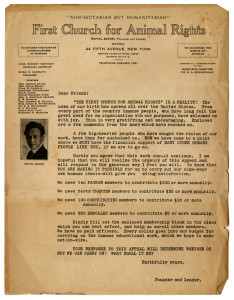
“Dear Friend: ‘THE FIRST CHURCH FOR ANIMAL RIGHTS’ IS A REALITY!” (Royal Dixon Papers)
The Royal Dixon Papers make a unique contribution to our Contemporary Literature Collection, providing insight into the naturalist preservation efforts in Houston during the first half of the Twentieth Century, as well as the LGBTQI community during the same time. For further information please consult the newly available finding aid. All of Royal Dixon’s original materials can be viewed in our reading room.
In addition to the over 7,000 linear feet of archival collections made available for study at the University of Houston Special Collections, we are also proud to offer over 100,000 rare and antique books for use in our reading room. Each month (some more dutifully than others) we will highlight a text from our collections and what makes it so special.
In the spring 2015 semester we had the good fortune to host our first-ever UH Special Collections Social Media Intern, Shelby Love. As part of her duties, Love curated a number of selections for our Book of the Month series here on the blog. For this month (and many to come, no doubt) we share a Book of the Month selection from Shelby Love.
Book of the Month: The Vision of Hell by Dante Alighieri, translated by Henry Francis Cary, and illustrated with the designs of M. Gustave Doré.
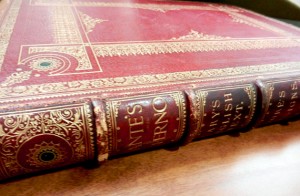
“Abandon all hope, ye who enter here.” The Vision of Hell by Dante Alighieri
Why so Special? In this 1866 edition, Dante Alighieri’s literary masterpiece is skillfully presented through the two archetypal interpretations of Henry Francis Cary and M. Gustave Doré. Cary, a graduate of Christ Church College, Oxford and assistant librarian in the British Museum, translated the Divine Comedy from Italian to English in the early 1800s. Despite the availability of numerous alternative translations, Cary’s version remained the standard into the twentieth century. That would be over 100 years of beating his competitors. In fact, his poetic translation was admired by other literary giants such as Wordsworth, Keats, Lamb, Coleridge, Macaulay, and Ruskin. Cary dedicated countless hours and even his own funds to complete the project for public consumption, truly a meritorious example of just how important our librarians are to society.
The second distinguished interpretation is through Doré’s vivid illustrations of the otherworldly adventure. Doré was an incredibly successful and productive French illustrator and printmaker in the 19th century known for his imaginative and fantastical artwork. His work was mainly centered around themes like the (pessimistic) fate of mankind and meditations on life and death, making him and Dante such a compatible ideological pair, the likes of which even match.com couldn’t hope to recreate. In fact, one contemporary critic found the illustrations to be so conscientious that he suggested Doré and the long deceased Dante were communicating through the occult. Dante enthusiasts and scholars still consider Doré a determiner for how the Divine Comedy is visualized by readers today, ranking his hypnotic renderings along with those of Sandro Botticelli, William Blake, Eugène Delacroix, and even Michael Angelo.
With a detailed red and gold hardcover, this edition is one of the most eye-catching items among our larger-format books. The sheer size of it can strike the modern day book lover as both whimsical and puzzling, eliciting the question, why would such a serious classic need to be so colossal? A rewarding perusal in the reading room will reveal a uniquely intimate way to engage with Dante’s beloved classic as Cary’s poetic translation of the writer’s imaginative vision is presented side by side with Doré’s exquisite renditions of the literary masterpiece. This incredible edition contains the crowning achievements of three fruitful lifetimes, brought together by one vision.
Location: Those interested in consulting with this edition of Dante’s classic may request call number PQ4315.2 .C4 1866 in the Special Collections Reading Room.
